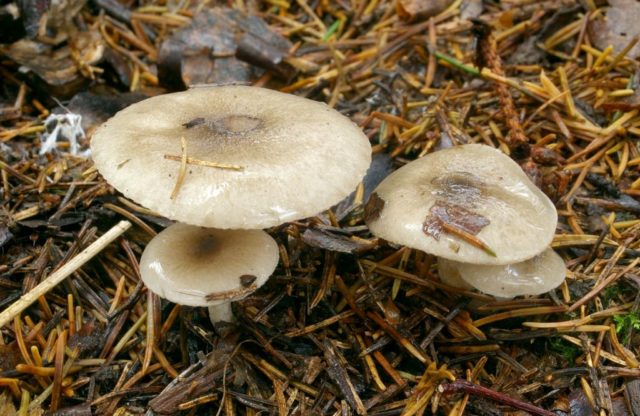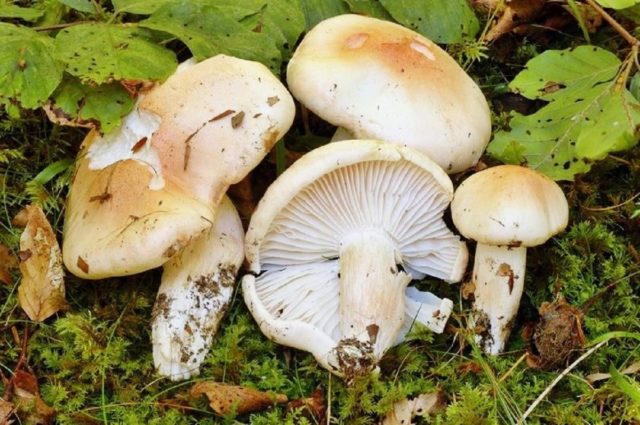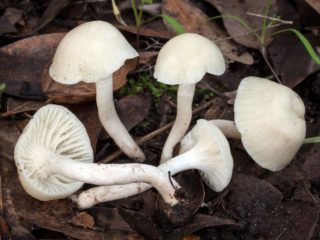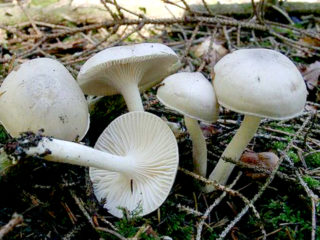Content
Spotted Gigrofor is an edible, lamellar mushroom of the Gigroforov family. Grows in deciduous and coniferous substrates from September to October. In order not to confuse a species with inedible specimens, it is important to be able to recognize it by external data.
What does Gigrofor spotted look like?
The mushroom has a small, convex-outstretched cap. The surface is covered with a gray film with numerous dark scales. The ribbed edges are fragile, snow-white in color. In rainy weather, the color brightens, the surface is covered with mucus, the scales become discolored.
The spore layer is formed by partially adherent white plates. Reproduction occurs by elongated spores, which are in a white powder.
Fleshy, dense leg covered with dark skin, with pronounced scales. Fibrous, sweetish pulp has no smell.

In rainy weather, the surface is covered with mucus
Where does the spotted hygrophor grow
Gigroforus spotted grows in coniferous and deciduous forests. It grows in numerous families on a damp substrate, bears fruit from September to October.
Is it possible to eat a spotted hygrophor
This representative belongs to the edible species. In cooking, only young, not overgrown specimens are used, without damage and signs of worminess.
False doubles
Gigrofor spotted has similar counterparts that can be eaten. In order not to harm your body, you need to be able to distinguish between them, and if the specimen is unknown, then it is better to pass by.
- Blushing - the mushroom is edible, but due to the lack of taste and smell, it does not have a high nutritional value. It can be recognized by its domed or open hat, pinkish-whitish in color with lemon spots. Grows in mixed forests from August to October.
Used in cooking fried and boiled
- Poetic - high quality edible mushroom. Grows on hills, among deciduous trees. Fruits in small groups throughout the warm period. You can recognize it by its glossy hat with uneven, slightly curved edges. The skin is colored light red, pale yellow or pink. Strong sticky stem with silvery fibers. The tasteless pulp has a pleasant jasmine aroma. It is used as food in fried, boiled form. For the winter, mushrooms can be preserved, dried and frozen.
Fleshy flesh exudes a pleasant jasmine aroma
Collection rules and use
Mushrooms are harvested in clear, dry weather. It is advisable to go on a quiet hunt in the morning. Since the pulp absorbs toxic substances like a sponge, mushroom hunting is carried out in ecologically clean places, far from roads and industrial enterprises.
After collecting, the mushrooms are carefully inspected for unsuitability, washed and boiled in salted water for several minutes. Prepared mushrooms are suitable for soups, fried and canned foods. Mushrooms can be dried for the winter.The dried product is laid out in paper or rag bags and stored in a dry, dark place. The shelf life should not exceed 12 months.
Conclusion
Spotted gigrofor is an edible representative of the mushroom kingdom. Appears in autumn, near spruce and deciduous trees. Since this specimen has an unattractive appearance and is easy to confuse with inedible species, it is important to know a detailed description, view photos and video materials.










